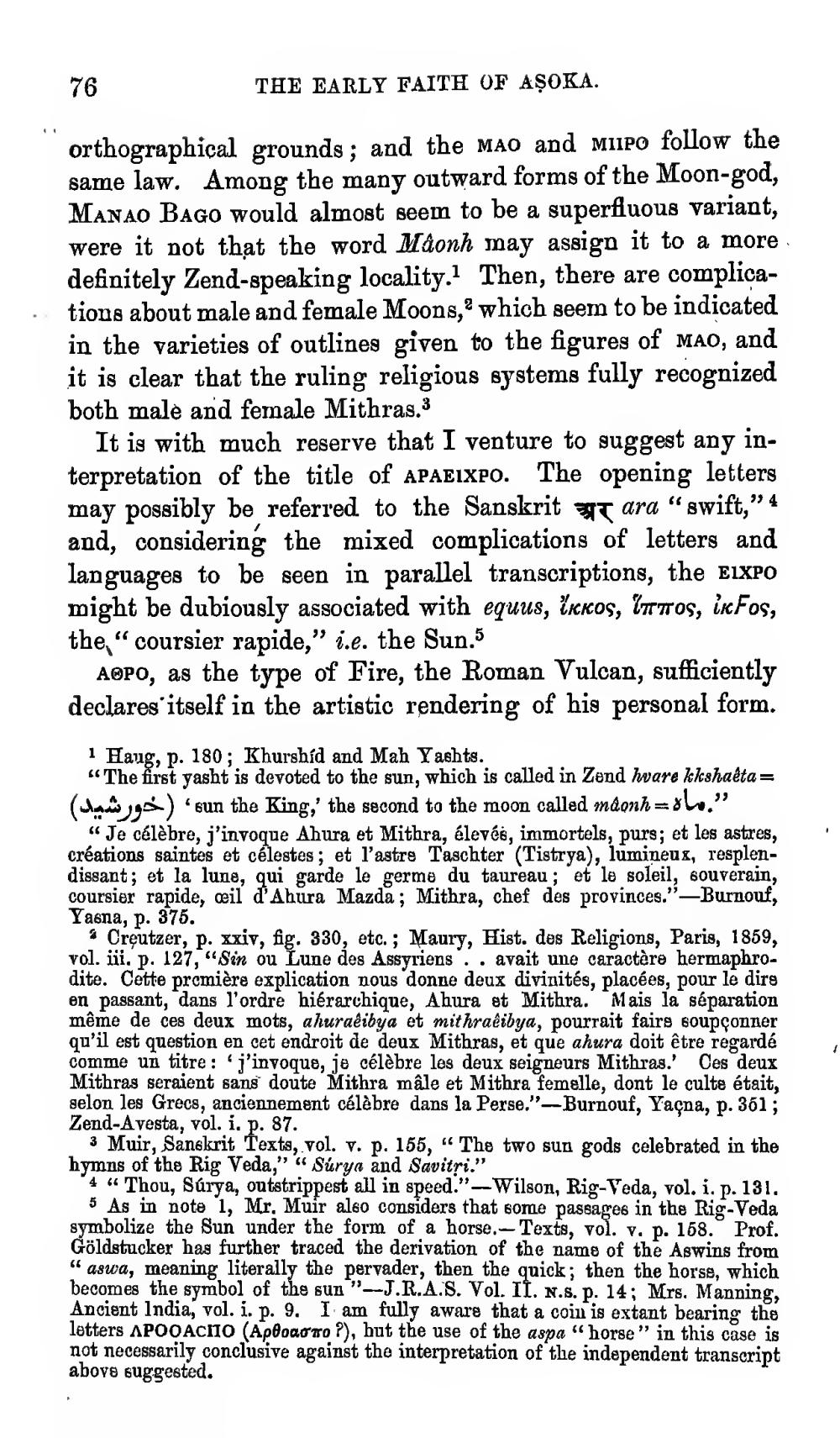________________
76
THE EARLY FAITH OF AŞOKA.
orthographical grounds; and the Mao and Miipo follow the same law. Among the many outward forms of the Moon-god, Manao Bago would almost seem to be a superfluous variant, were it not that the word Mâonh may assign it to a more definitely Zend-speaking locality. Then, there are complications about male and female Moons, which seem to be indicated in the varieties of outlines given to the figures of Mao, and it is clear that the ruling religious systems fully recognized both male and female Mithras.3
It is with much reserve that I venture to suggest any interpretation of the title of APAEIXPO. The opening letters may possibly be referred to the Sanskrit T ara "swift," 4 and, considering the mixed complications of letters and languages to be seen in parallel transcriptions, the EiXPO might be dubiously associated with equus, ikkoS, CTOS, infos, the "coursier rapide," i.e. the Sun.5
A®PO, as the type of Fire, the Roman Vulcan, sufficiently declares itself in the artistic rendering of his personal form.
1 Haug, p. 180; Khurshid and Mah Yashts. “The first yasht is devoted to the sun, which is called in Zend hvare kkshaêta= ( ) sun the King,' the second to the moon called mdonh=sho."
“Je célèbre, j'invoque Ahura et Mithra, élevés, immortels, purs; et les astres, créations saintes et célestes; et l'astre Taschter (Tistrya), lumineux, resplendissant; et la lune, qui garde le germe du taureau ; et le soleil, souverain, coursier rapide, weil d'Ahura Mazda ; Mithra, chef des provinces." —Burnouf, Yasna, p. 375.
Creutzer, p. xxiv, fig. 330, etc.; Maury, Hist. des Religions, Paris, 1859, vol. iii. p. 127, “Sin ou Lune des Assyriens .. avait une caractère hermaphrodite. Cette première explication nous donne deux divinités, placées, pour le dire en passant, dans l'ordre hiérarchique, Ahura et Mithra. Mais la séparation même de ces deux mots, ahuraêibya et mithraêibya, pourrait faire soupçonner qu'il est question en cet endroit de deux Mithras, et que ahura doit être regardé comme un titre : j'invoque, je célèbre les deux seigneurs Mithras. Ces deux Mithras seraient sans doute Mithra mâle et Mithra femelle, dont le culte était, selon les Grecs, anciennement célèbre dans la Perse."--Burnouf, Yacna, p. 361; Zend-Avesta, vol. i. p. 87.
3 Muir, Sanskrit Texts, vol. v. p. 155, “The two sun gods celebrated in the hymns of the Rig Veda," " Súrya and Savitri.”
4 "Thou, Súrya, outstrippest all in speed." -- Wilson, Rig Veda, vol. i. p. 131.
5 As in note 1, Mr, Muir also considers that some passages in the Rig Veda symbolize the Sun under the form of a horse.- Texts, vol. v. p. 158. Prof. Göldstucker has further traced the derivation of the name of the Aswins from "aswa, meaning literally the pervader, then the quick; then the horse, which becomes the symbol of the sun "--J.R.A.S. Vol. II. N.s. p. 14; Mrs. Manning, Ancient India, vol. i. p. 9. I am fully aware that a coin is extant bearing the letters APOOAchio (Aploaoro?), but the use of the aspa "horse" in this case is not necessarily conclusive against the interpretation of the independent transcript aboys suggested.




